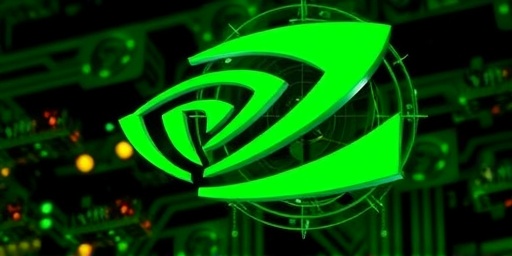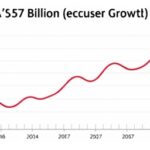In a boost for tech investors, Nvidia Corporation announced record quarterly sales that have temporarily quelled fears of an impending AI bubble burst. The semiconductor giant reported revenue of $26.04 billion for its fiscal fourth quarter ending January 28, 2024, surpassing Wall Street expectations and marking a staggering 265% year-over-year increase. This surge, driven by explosive demand for AI chips, has steadied the stock market’s nerves around artificial intelligence investments. However, beneath the optimism, analysts are raising red flags about the sustainability of this growth, warning that heavy upfront investments in AI infrastructure could pose significant risks to banks and the broader US economy if promised returns fail to materialize.
Nvidia‘s Q4 Revenue Soars on AI Chip Demand
Nvidia‘s latest earnings report has solidified its position as the undisputed leader in the AI hardware space. The company’s data center segment, which powers much of the AI revolution, generated $18.4 billion in revenue—up an astonishing 409% from the same period last year. This figure alone accounted for over 70% of Nvidia’s total sales, underscoring the semiconductor firm’s pivot from gaming graphics to high-performance computing essential for training large language models like those behind ChatGPT.
CEO Jensen Huang highlighted the momentum during the earnings call, stating, “The age of AI has arrived, and our customers are deploying AI at an unprecedented scale.” Key products like the H100 GPU, priced at around $30,000 per unit, have seen supply shortages, with major cloud providers such as Microsoft, Amazon, and Google snapping up inventories to fuel their AI ambitions. Nvidia’s gross margin also improved to 76.7%, reflecting pricing power in a market where demand far outstrips supply.
Financially, Nvidia beat analyst estimates handily: revenue projections were around $22.8 billion, but the actual haul exceeded that by over $3 billion. Net income jumped to $12.3 billion, or $4.93 per diluted share, compared to just $1.4 billion in the prior year’s quarter. These numbers not only propelled Nvidia’s stock up 16% in after-hours trading following the announcement but also contributed to a broader rally in the stock market, with the Nasdaq Composite gaining 2.5% the next day.
Looking at the semiconductor sector, Nvidia’s performance is a bright spot amid a mixed landscape. While competitors like AMD and Intel struggle to match Nvidia’s AI dominance, the overall industry benefits from the halo effect. Global semiconductor sales reached $526.8 billion in 2023, according to the Semiconductor Industry Association, with AI-related chips expected to drive 20% annual growth through 2027.
AI Bubble Fears Subside as Nvidia Delivers Results
The AI bubble narrative has dominated headlines since late 2023, with skeptics comparing the frenzy to the dot-com crash of 2000. Investors poured over $100 billion into AI startups and infrastructure last year, fueling concerns that valuations—Nvidia’s market cap alone hit $2.2 trillion—were detached from fundamentals. Yet, Nvidia’s blowout quarter has provided a much-needed reality check, suggesting that AI is more than hype.
Stock market reactions were swift and positive. Nvidia shares, which had dipped 5% earlier in the week amid broader market volatility, surged past $800 per share post-earnings, adding over $200 billion to the company’s valuation in a single session. This performance rippled through the tech sector, lifting peers like Broadcom and Taiwan Semiconductor Manufacturing Company (TSMC), Nvidia’s key foundry partner.
Analysts at firms like Goldman Sachs noted the calming effect. “Nvidia’s results demonstrate tangible demand for AI semiconductors, easing immediate bubble fears,” said a report from the investment bank. The company’s order backlog stands at $15 billion, with CEO Huang projecting $24 billion in revenue for the current quarter—another record. This visibility into future sales has reassured the stock market that AI investments are yielding short-term wins, at least for Nvidia.
However, not all is rosy. The AI bubble debate persists, with critics pointing to the concentration of growth in a few hyperscalers. Amazon Web Services, Microsoft Azure, and Google Cloud accounted for nearly 50% of Nvidia’s data center revenue, per estimates from Bloomberg. If these giants slow spending—amid rising interest rates and economic uncertainty—the ripple effects could be profound for the US economy, which relies on tech for 10% of GDP.
Analysts Caution on AI Spending’s Financial Pitfalls
While Nvidia’s success story captivates, a chorus of analysts is tempering enthusiasm with warnings about systemic risks. The massive upfront costs of AI deployment—estimated at $1 trillion globally by 2027, per McKinsey—could strain corporate balance sheets and expose banks to lending vulnerabilities if AI-driven profits don’t pan out as expected.
Morgan Stanley’s Joseph Moore, a senior tech analyst, expressed concerns in a recent note: “The AI bubble may not burst imminently, but the reliance on perpetual capex increases is unsustainable. Banks financing data center expansions could face defaults if ROI timelines extend beyond five years.” Indeed, US banks have extended over $200 billion in loans to tech firms for AI infrastructure since 2022, according to Federal Reserve data, heightening exposure in a high-interest-rate environment.
The broader financial system is at stake. Rating agency Moody’s highlighted that non-bank lenders, including venture debt providers, are particularly vulnerable. “If AI hype fades without corresponding revenue growth, we could see a credit crunch similar to 2008, but centered on tech debt,” warned a Moody’s report. Nvidia itself isn’t immune; its capital expenditures rose 50% year-over-year to $1.2 billion, funding R&D for next-gen chips like the Blackwell architecture.
Quotes from industry voices add weight. Wedbush Securities’ Dan Ives, bullish on Nvidia, still cautioned, “This is a gold rush, but gold rushes end. The stock market loves the story now, but watch for cracks in enterprise adoption.” Ives predicts AI spending will hit $300 billion annually by 2026, but only if economic conditions remain favorable— a big if, given inflation at 3.1% and potential recession signals.
In the semiconductor space, these warnings translate to volatility. While Nvidia thrives, smaller players face margin pressures from rising raw material costs and geopolitical tensions over Taiwan, home to 90% of advanced chip production.
Semiconductor Surge Influences Broader Stock Market Trends
Nvidia’s dominance is reshaping the semiconductor industry and, by extension, the stock market. The Philadelphia Semiconductor Index (SOX) climbed 4% following the earnings release, reflecting investor confidence in AI as a secular growth driver. Semiconductors, often a bellwether for the US economy, now hinge on AI narratives more than cyclical factors like consumer electronics.
Key statistics paint a vivid picture: Nvidia controls 80-90% of the AI GPU market, per IDC research, leaving little room for rivals. This monopoly-like position has driven its P/E ratio to 60x forward earnings—premium compared to the S&P 500’s 20x average—but justified by 100%+ growth projections. The stock market’s tech-heavy indices, like the “Magnificent Seven,” owe much of their 2023 gains (over 50% for Nasdaq) to AI plays led by Nvidia.
Yet, risks abound. Supply chain disruptions, including US export controls on advanced chips to China, could cap growth. Nvidia’s revenue from China dropped 20% last quarter due to these restrictions, prompting diversification efforts into Europe and India. Investors are also eyeing antitrust scrutiny; the FTC has signaled probes into Big Tech’s AI investments, which could indirectly hit Nvidia suppliers.
Broader stock market implications include rotation risks. As AI enthusiasm wanes, capital might flow to undervalued sectors like energy or financials. JPMorgan estimates that a 10% pullback in Nvidia could shave 1-2% off the S&P 500, given its weighting. For the US economy, semiconductors contribute $250 billion annually, supporting 300,000 jobs—vital amid 4.1% unemployment.
Future Outlook: Balancing AI Growth with Economic Stability
As Nvidia charts its course into 2024, the sustainability of the AI boom will be the litmus test for the US economy. With guidance for $24-25 billion in Q1 revenue, the company signals continued strength, but analysts urge caution. The path forward involves navigating regulatory hurdles, like the CHIPS Act’s $52 billion in subsidies aimed at domestic semiconductor production, which could bolster Nvidia’s ecosystem.
Forward-looking, experts predict AI could add $15.7 trillion to global GDP by 2030, per PwC, but only if investments yield efficiencies in sectors like healthcare and manufacturing. For banks, stress tests will be crucial; the Fed’s 2024 scenarios include AI-related downturns to gauge resilience.
In the stock market, Nvidia remains a buy for growth investors, but diversification is key. As Huang noted, “AI is transforming every industry,” yet the transition carries risks. If profits materialize, it could avert an AI bubble collapse; otherwise, the fallout might ripple through semiconductors, lending, and the US economy at large. Investors and policymakers alike will watch Nvidia’s next moves closely, as they hold clues to whether this revolution endures or deflates.









